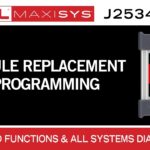Understanding Caterpillar Fault Codes is crucial for diagnosing and resolving issues with your heavy equipment. These codes, identified by their PID (Parameter Identifier), SID (Suspect Parameter Number), and FMI (Failure Mode Identifier), provide valuable insights into the root cause of malfunctions. This guide will delve into the intricacies of Caterpillar fault codes, providing a detailed list of common codes and their descriptions.
Decoding Caterpillar Fault Codes: PID, SID, and FMI
Caterpillar fault codes are structured using three key components:
- PID (Parameter Identifier): This number identifies the specific parameter being monitored by the Electronic Control Unit (ECU). Examples include engine speed, fuel pressure, and coolant temperature.
- SID (Suspect Parameter Number): This number pinpoints the specific component or system suspected of causing the fault. It often corresponds to a sensor, actuator, or circuit.
- FMI (Failure Mode Identifier): This number describes the nature of the fault, such as a short circuit, open circuit, or abnormal signal.
Common Caterpillar Fault Codes List
The following table lists common Caterpillar fault codes, along with their corresponding PID, SID, FMI, fault, and description. Note that this is not an exhaustive list, and specific codes may vary depending on the equipment model and year.
| PID/SID | FMI | Fault | Description |
|---|---|---|---|
| 1 | 11 | Injector Solenoid Cyl#1 | Current Below Normal or Open Circuit |
| 32 | 5 | Turbo Wastegate Solenoid | Current Below Normal |
| 41 | 3 | 8 Volt Supply | Voltage Above Normal or Shorted High |
| 64 | 2 | Speed Sensor | Loss of Signal |
| 94 | 1 | Fuel Pressure | Low Fuel Pressure |
| 100 | 1 | Oil Pressure Sensor | Low Pressure Warning |
| 110 | 0 | Coolant Temp Sensor | Temperature Above Normal Range |
| 190 | 0 | Engine Speed | Overspeed Warning |
| 231 | 12 | J1939 Data | Loss of Data Signal |
| 320 | 11 | ATD | ATD Filter Temperature Very High |
| 332 | 11 | Aftertreatment Fuel Pressure Control | Aftertreatment Fuel Pressure High |
Utilizing Caterpillar Diagnostic Tools: CAT ET and CAT SIS
For in-depth diagnostics and troubleshooting, specialized software like Caterpillar Electronic Technician (CAT ET) and Caterpillar Service Information System (CAT SIS) are essential. These programs allow technicians to:
- Retrieve and interpret fault codes
- Monitor real-time sensor data
- Perform diagnostic tests
- Access service manuals and parts information
Accessing Caterpillar Fault Code Information
Various resources are available for accessing comprehensive Caterpillar fault code information, including:
- Online Databases: Several websites offer searchable databases of Caterpillar fault codes.
- Service Manuals: Caterpillar publishes detailed service manuals for each equipment model, containing extensive troubleshooting information.
- Diagnostic Software: Programs like CAT ET and CAT SIS provide direct access to fault code definitions and diagnostic procedures.
Conclusion
Caterpillar fault codes play a vital role in maintaining the health and performance of heavy equipment. By understanding these codes and utilizing the appropriate diagnostic tools, technicians can efficiently identify and resolve issues, minimizing downtime and maximizing productivity. Consult official Caterpillar resources or qualified technicians for accurate diagnosis and repair guidance.


